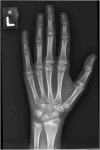SOX2 Variant Resulting in Hypogonadotropic Hypogonadism, Learning Difficulties, and Ear (Rather Than Eye) Anomalies
- PMID: 40496471
- PMCID: PMC12150396
- DOI: 10.1210/jcemcr/luaf126
SOX2 Variant Resulting in Hypogonadotropic Hypogonadism, Learning Difficulties, and Ear (Rather Than Eye) Anomalies
Abstract
A 15-year-old female individual presented with primary amenorrhea and absence of pubertal signs. Her hormonal profile revealed isolated hypogonadotropic hypogonadism (IHH) with low levels of luteinizing hormone (LH), estradiol, and follicle-stimulating hormone (FSH), with a confirmatory luteinizing hormone-releasing hormone (LHRH) stimulation test. She has a background of global developmental delay and bilateral hearing loss, with computed tomography (CT) findings of an absent right incus lenticular process and a dilated right vestibule. Genetic testing revealed a heterozygous pathogenic variant c.152G>A (p.Trp51*) in the SOX2 gene. SOX2 (sex-determining region Y-box 2) is a transcription factor critical for early pituitary and hypothalamic development. However, the phenotype associated with SOX2 pathogenic variants remains incompletely defined due to its rarity and wide phenotypic variability. Our case uniquely highlights temporal bone anomalies and a comprehensive pituitary function workup, which may contribute to a clearer understanding of SOX2-related phenotypic presentations. This case underscores the need to consider SOX2 pathogenic variants in the genetic evaluation of IHH, even in the absence of ocular abnormalities.
Keywords: SOX2 variant; delayed puberty; hearing loss; hypogonadotropic hypogonadism; ocular anomalies.
© The Author(s) 2025. Published by Oxford University Press on behalf of the Endocrine Society.
Figures





Similar articles
-
Normosmic idiopathic hypogonadotropic hypogonadism due to a novel GNRH1 variant in two siblings.Endocrinol Diabetes Metab Case Rep. 2020 Mar 5;2020:19-0145. doi: 10.1530/EDM-19-0145. Online ahead of print. Endocrinol Diabetes Metab Case Rep. 2020. PMID: 32134721 Free PMC article.
-
Heterozygous mutations in SOX2 may cause idiopathic hypogonadotropic hypogonadism via dominant-negative mechanisms.JCI Insight. 2023 Feb 8;8(3):e164324. doi: 10.1172/jci.insight.164324. JCI Insight. 2023. PMID: 36602867 Free PMC article.
-
The response of pituitary gonadotropes to a constant infusion of luteinizing hormone-releasing hormone (LHRH) in normal prepubertal and pubertal children and in children with abnormalities of sexual development.J Clin Endocrinol Metab. 1976 Aug;43(2):400-11. doi: 10.1210/jcem-43-2-400. J Clin Endocrinol Metab. 1976. PMID: 780368
-
GnRH receptor and GPR54 inactivation in isolated gonadotropic deficiency.Best Pract Res Clin Endocrinol Metab. 2006 Dec;20(4):515-28. doi: 10.1016/j.beem.2006.10.005. Best Pract Res Clin Endocrinol Metab. 2006. PMID: 17161329 Review.
-
Congenital hypogonadotropic hypogonadism in females: clinical spectrum, evaluation and genetics.Ann Endocrinol (Paris). 2010 May;71(3):158-62. doi: 10.1016/j.ando.2010.02.024. Epub 2010 Apr 3. Ann Endocrinol (Paris). 2010. PMID: 20363464 Review.
References
-
- Lima Amato LG, Latronico AC, Gontijo Silveira LF. Molecular and genetic aspects of congenital isolated hypogonadotropic hypogonadism. Endocrinol Metab Clin North Am. 2017;46(2):283‐303. - PubMed
-
- Topaloglu AK, Kotan LD. Genetics of hypogonadotropic hypogonadism. Endocr Dev. 2016;29:36‐49. - PubMed
-
- Williamson KA, Yates TM, FitzPatrick DR, et al. SOX2 Disorder. In: Adam MP, Feldman J, Mirzaa GM, et al. eds. GeneReviews® [Internet]. University of Washington, Seattle; 1993-2025. February 23, 2006 [Updated July 30, 2020]. - PubMed
-
- Shima H, Ishii A, Wada Y, et al. SOX2 nonsense mutation in a patient clinically diagnosed with non-syndromic hypogonadotropic hypogonadism. Endocr J. 2017;64(8):813‐817. - PubMed
Publication types
LinkOut - more resources
Full Text Sources
